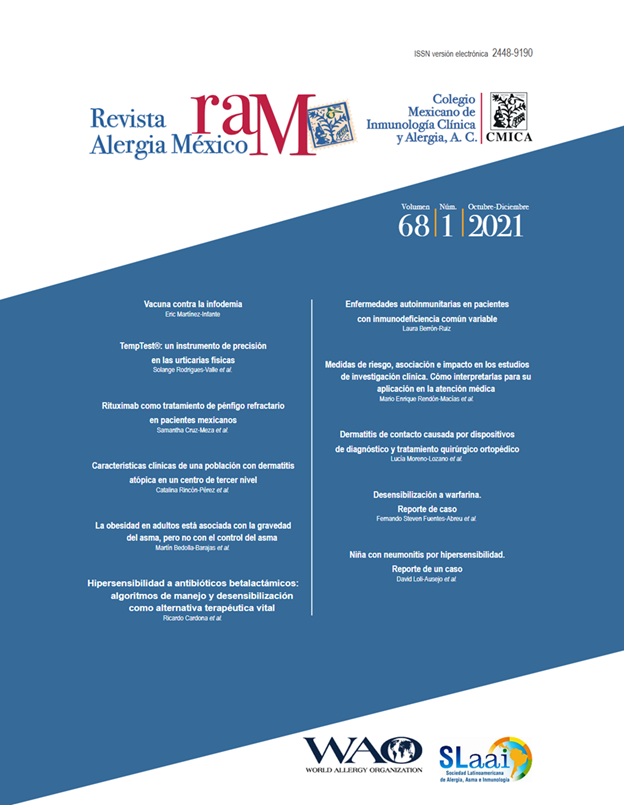Abstract
Background: Hypersensitivity pneumonitis entails several inflammatory lung diseases that preferentially affect the alveolar and perialveolar tissue. It is a very rare disease in children, with a complicated diagnosis due to the fact that antigen exposure usually goes unnoticed.
Case report: A 12-year-old girl with dry cough, dyspnea, wheezing, and tachypnea, with partial improvement after treatment with inhaled bronchodilators and corticoids. The spirometry showed a restrictive pattern and reduced lung diffusion capacity; in the CT scan, centrilobular ground-glass opacities were observed, and a lymphocyte count of CD4/CD8 of 2.46 (lymphocytosis) was obtained from the bronchoalveolar lavage. IgG positivity to bird feathers was obtained.
Conclusions: The treatment of hypersensitivity pneumonitis is based on avoiding exposure to the causative agent, which is determined by the prognosis; for which taking an extensive medical history is of paramount importance. Corticosteroids can be prescribed based on the clinical response, the pulmonary function, and the radiological improvement.
References
Jordan LE, Guy E. Paediatric feather duvet hypersensitivity pneumonitis. BMJ Case Rep. 2015;2015:bcr2014207956. DOI: 10.1136/bcr-2014-207956
Spagnolo P, Rossi G, Cavazza A, Bonifazi M, Paladini I, Bonella F, et al. Hypersensitivity pneumonitis: a comprehensive review. J Investig Allergol Clin Immunol. 2015;25(4):237-250. Disponible en: http://www.jiaci.org/issues/vol25issue4/1.pdf
Sahin H, Kaproth-Joslin K, Hobbs SK. Hypersensitivity pneumonitis. Semin Roentgenol. 2019;54(1):37-43. DOI: 10.1053/j.ro.2018.12.004
Soumagne T, Dalphin ML, Dalphin JC. Hypersensitivity pneumonitis in children. Rev Mal Respir. 2019;36(4):495-507. DOI: 10.1016/j.rmr.2018.06.010
Habra B, AbdulWahab A. A rare pediatric case of severe Bird Fancier’s Lung presented with viral pneumonitis-like picture. Children (Basel). 2018;5(11):149. DOI: 10.3390/children5110149
Griese M, Haug M, Hartl D, Teusch V, Glöckner-Pagel J, Brasch F, et al. Hypersensitivity pneumonitis: lessons for diagnosis and treatment of a rare entity in children. Orphanet J Rare Dis. 2013;8:121. DOI: 10.1186/1750-1172-8-121
Ratjen F, Costabel U, Griese M, Paul K. Bronchoalveolar lavage fluid findings in children with hypersensitivity pneumonitis. Eur Respir J. 2003;21(1):144-148. DOI: 10.1183/09031936.03.00035703a
Fernández-Pérez ER, Swigris JJ, Forssén AV, Tourin O, Solomon JJ, Huie TJ, et al. Identifying an inciting antigen is associated with improved survival in patients with chronic hypersensitivity pneumonitis. Chest. 2013;144(5):1644-1651. DOI: 10.1378/chest.12-2685
Ryerson CJ, Vittinghoff E, Ley B, Lee JS, Mooney JJ, Jones KD, et al. Predicting survival across chronic interstitial lung disease: the ILD-GAP model. Chest. 2014;145(4):723-728. DOI: 10.1378/chest.13-1474
Sisman Y, Buchvald F, Blyme AK, Mortensen J, Nielsen KG. Pulmonary function and fitness years after treatment for hypersensitivity pneumonitis during childhood. Pediatr Pulmonol. 2016;51(8):830-837. DOI: 10.1002/ppul.23360

This work is licensed under a Creative Commons Attribution-NonCommercial 4.0 International License.
Copyright (c) 2021 Revista Alergia México





